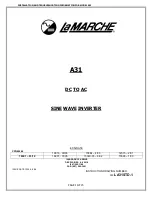
32 | SAMLEX AMERICA INC.
SAMLEX AMERICA INC. | 33
- Les résistances des câbles interconnectés seront pas équilibrées
- Tous les batteries/ fils de batterie dans la série n’auront pas la même résistance
- Toutes les batteries individuelles vont recharger à des courants différentes, ainsi
elles atteindront un état de rechargement complèt mais en décalage.
- La batterie ayant le moins de résistance dans la série prendrait moins de temps
pour être rechargée comparé aux autres batteries. Alors elle serait surchargée et,
en conséquence aurait une vie plus courte.
7.16 SIZING THE INVERTER BATTERY BANK
One of the most frequently asked questions is, "how long will the batteries last?" This
question cannot be answered without knowing the size of the battery system and the
load on the inverter. Usually this question is turned around to ask “How long do you
want your load to run?”, and then specific calculation can be done to determine the
proper battery bank size. There are a few basic formulae and estimation rules that are
used:
1. Active Power in Watts (W) = Voltage in Volts (V) x Current in Amperes (A)
x Power Factor.
2. For an inverter running from a 12V battery system, the approximate DC current re-
quired from the 12V batteries is the AC power delivered by the inverter to the load
in Watts (W) divided by 10 & for an inverter running from a 24V battery system, the
approximate DC current required from the 24V batteries is the AC power delivered
by the inverter to the load in Watts (W) divided by 20.
3. Energy required from the battery = DC current to be delivered
(A) x Time in Hours (H).
The first step is to estimate the total AC watts (W) of load(s) and for how long the
load(s) will operate in hours (H). The AC watts are normally indicated in the electrical
nameplate for each appliance or equipment. In case AC watts (W) are not indicated,
Formula 1 given above may be used to calculate the AC watts. The next step is to
estimate the DC current in Amperes (A) from the AC watts as per Formula 2 above. An
example of this calculation for a 12V inverter is given below:
Let us say that the total AC Watts delivered by the inverter = 1000W.
Then, using Formula 2 above, the approximate DC current to be delivered by the 12V
batteries = 1000W ÷10 = 100 Amperes, or by 24V batteries = 1000W ÷ 20 = 50A.
Next, the energy required by the load in Ampere Hours (Ah) is determined.
For example, if the load is to operate for 3 hours then as per Formula 3 above, the
energy to be delivered by the 12V batteries = 100 Amperes × 3 Hours = 300 Ampere
Hours (Ah), or by the 24V batteries = 50A x 3 Hrs = 150 Ah.
SECTION 7 |
General Information - Battery Related
















































